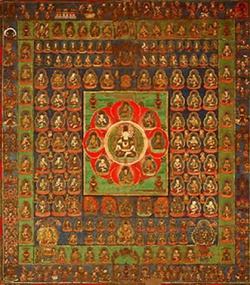The Diamond and Womb World Mandalas
The best documented and most thoroughly studied examples of early Buddhist mandalas are the Diamond Matrix World and Womb Matrix World [Sanskrit: "Garbhadhatu", Japanese "Taizo-kai"] mandalas of the Shingon order in Japan. Both have structural parallels to variants of the mandala of the Eight Great Bodhisattvas: a buddha surrounded by eight bodhisattvas forms the core of the Womb World mandala, and a ninefold arrangement is repeated also in the structure of the Diamond World mandala.
Examples of both mandalas are said to have been brought to Japan from China in the early ninth century by Kukai [774-835 ce]. With the exception, however, of an eighth-century Diamond World mandala incised into the tops, sides, and back of a funerary casket, unearthed during the excavation of an underground chamber at the Famensi monastery near Xian in the early 1980s, no Chinese prototypes are extant
Also known as Kobo Daishi, Kukai is revered today as the founder of the Shingon order in Japan, and the practices and imagery of this school are well documented in contemporary scholarship. In this tradition, the Womb and Diamond World mandalas are shown as a pair and placed to the east and west of an altar in the inner precinct of a temple.
The Womb World symbolizes the possibility of buddhahood in the phenomenal world as it is perceived by a practitioner, while the Diamond World is a guide to the spiritual practice that leads to enlightenment. Each mandala is based [to some degree] on a different text: the Womb World derives from the version of the Mahavairochana Sutra translated from Sanskrit into Chinese by Subhakarasimha [637 - 735 in the 8th century.
The Diamond World is based on the Sarvatathagatatattvasamgraha Sutra translated by Amoghavajra [705 - 774] during the same period. Together with Vajrabodhi [669 - 741], these monks are revered as the founders of Esoteric Buddhism in China. Their journeys throughout South, Southeast, and Central Asia illustrate the international nature of Buddhist culture during the seventh through ninth centuries, and exemplify the transmission of Yoga tantra at that time.
The earliest extant Japanese versions of these mandalas, known as the Takao Mandaras,"8 are preserved in the Tingo-ji temple in Kyoto. Executed in gold and silver pigments on a purple- dyed damask, these two paintings are believed to have been made by Kukai at the request of Emperor Junna [reigned 823 - 834]. Two similar paintings from the second half of the ninth century in the To-ji temple in Kyoto, said to be copies of those made in China at the request of Emperor Montoku [reigned 850 - 858], provide further evidence for the longevity of this pair of mandalas in Japan.
Numerous later examples, such as a late thirteenth- or early fourteenth-century pair in the Brooklyn Museum or a Muromachi-period pair in the Memor Gallery, as well as iconographic drawings detailing various images from the two mandalas, are also known.
